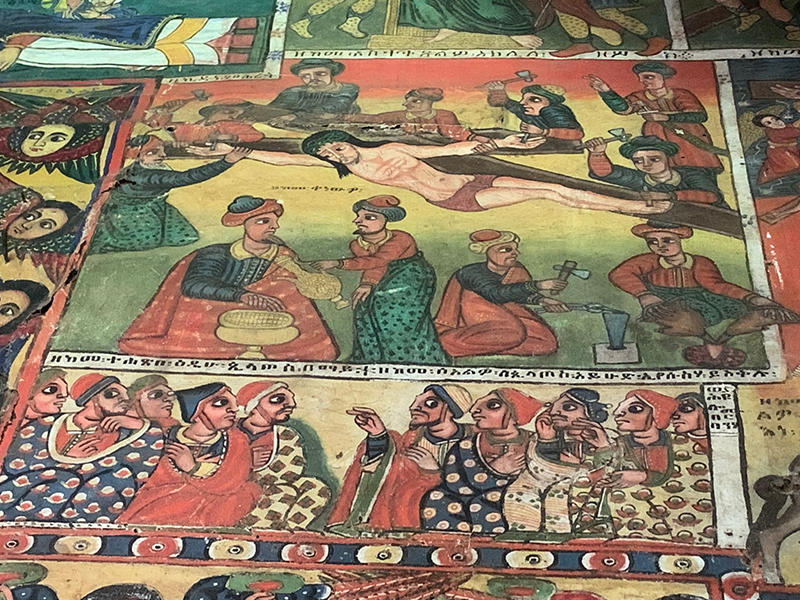Marcia Kupfer
Sites of Anti-Judaism in Ethiopian Art and Culture
My residency at the Center proved transformative for my project. First and foremost, the library resources associated with the fellowship jump-started research that I simply could not pursue during months of pandemic-related lockdowns. Because I am investigating questions not previously asked by Ethiopianists—How did imported Catholic visual culture and autochthonous traditions affect the representation of Jews? What were the ramifications for the social construction of the Beta Israel (Ethiopian Jews)?—I needed to scour collections of images and primary texts as well as scholarly studies for clues. Publications essential to my inquiry exist mostly in the form of physical books that had to be sought from multiple libraries nationwide, or, if they were digitized, institutional requirements for electronic access rendered them inaccessible. From mid-June to mid-August, the National Gallery’s interlibrary loan staff processed some 60 titles for me. I systematically worked through reams of bibliography: Ethiopian primary sources (editions of Ge’ez texts with English, German, and Italian translations); European primary sources (15th-century Portuguese accounts, writings from the Jesuit missions of the 16th–17th centuries, 18th-century travelogues, and modern-era missionary reports); studies of Ethiopian art (including monographs, exhibition catalogs, conference proceedings, and albums of reproductions); histories of Ethiopian society and its various groups, including the Beta Israel; and histories of the worldwide Jesuit missions in their colonial contexts. This deep dive allowed me to follow specific threads and, equally important, to assess their place within the broader scope of Ethiopian art and culture.

West exterior wall of the maqdas showing the nailing of Christ to the Cross, with blacksmiths making the nails at right, Pontius Pilate washing his hands at left, and Jews with hooked noses demanding Christ’s execution in the lower register. Ura Kidane Mehret (Zege Peninsula, Lake Tana, Ethiopia), later 18th century. Photo: Marcia Kupfer
I only slightly exaggerate when I say that a world of evidence I had not anticipated leaped off the pages. To be sure, specialists persuasively attribute the formation of the Beta Israel to multifactorial developments internal to Ethiopian society. Still, I can now show that, concomitantly, the influx of visual materials channeled through external political and religious ties had a profound impact on the out-group’s representation. By the 17th century, the landless Beta Israel had come to be collectively identified with specializations in despised trades, like blacksmithing (men) and pottery (women). These occupations, which entailed the fiery transformation of matter, thus associated Beta Israel artisans with the demonic magic (buda) personified by the shape-shifting, bloodthirsty hyena. At the same time, Portuguese emissaries (1515–1526) and soldiers (1541–1543), followed by Jesuit missionaries (1555–1634) and sympathizers (1698), disseminated Passion iconography replete with motifs—rooted in late medieval typologies and narratives—that identified Jews as the original smiths, as the inventors of nails for the express purpose of impaling bodies to the cross, as the makers of the nails for the Crucifixion, and as participants in that scene. In sum, Catholic imagery offered novel ways of derogating an ethno-religious caste. It Judaized ironwork, the very craft emblematic of the Beta Israel, whose depiction as Christ’s tormentors resonated with the diabolical role of smiths in talismanic incantations and with fire-breathing, devil-bearing hyenas in saints’ lives. If, already in my application, I had pinpointed a cluster of individual anti-Jewish tropes, I now gained a fuller understanding of their mutual entanglements.
I am at work on a first, short-form article, “Nails and Blacksmiths in Ethiopian Art (Thirteenth–Nineteenth Centuries),” for a special issue of the journal Codex Aquilarensis: Revista de Arte Medieval, which will anthologize papers presented at a colloquium in northern Spain to honor Professor Herbert L. Kessler. But insights gained from my summer research have given me a new perspective on the larger import of my project. The longer study will integrate Ethiopia into modernizing circuits of defamatory knowledge about Jews that, as recent studies by Magda Teter and François Soyer reveal, stretched from Western Europe to Poland and Peru. Notwithstanding Ethiopian rejection of Catholic dogma, imported visual apparatuses fueled local iconographies of Jewish enmity that rhymed with globally proliferating tropes of sadistic Jews, their spiky instruments of torture, consumption of blood, and exploitation of wealth and power to the detriment of their neighbors. The evidence that I have drawn from the corpus of Ethiopian art complements the picture, built through primary textual sources, of the emperors’ schooling in Jewish matters by their Catholic interlocutors—from the Iberian expulsions and Portuguese Jews’ rituals (16th century) to Muslim-Jewish relations and the Talmud (18th century). Ethiopia’s relative isolation from the Christian West did not preclude the absorption and representation of European anti-Jewish discourses and stereotypes.
Washington, DC
Paul Mellon Visiting Senior Fellow, summer 2021
Marcia Kupfer plans to further her research in Ethiopian art so as to integrate the material into a broader, comparative study of how Judaism and Jews are represented in diverse Christian traditions.
